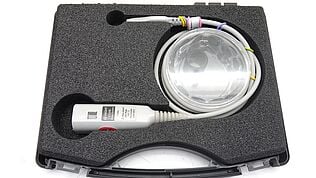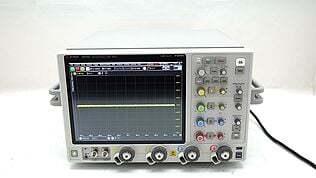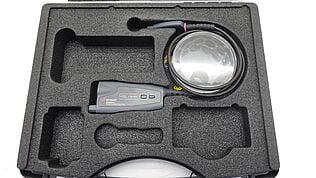How to select the right oscilloscope probes
Back to overview of articles from the Oscilloscopes Basics series
Are you an electrical engineer looking to get the most out of your oscilloscope? If so, choosing the right probes is essential. We provide an overview of the different probe types available, their bandwidth requirements, compatibility, and tips for proper probing techniques. Whether you're a pro or just starting out, this post will help improve your measurement accuracy and performance. Let’s dive in.
Why probes are so important
As you are choosing the right Keysight used oscilloscope for your needs, you might also consider which probes to use with it – and rightfully so. Probes physically connect your oscilloscope to the device or signal under test. That is why they are vital for producing useful measurements for your project. Therefore, you will need to be aware how oscilloscope probes affect your measurement. When choosing probes you are likely looking for good value for money, sufficient signal fidelity and a minimum impact on the circuit being measured. But how do you find a probe like that?
How to find the right probe for your Keysight used oscilloscope
To find the right probe for your Keysight used oscilloscope, first consider the different types of oscilloscope probes to decide which one is needed for the measurement you are intending to make.
- Passive Probes. Good news first: If you buy a used MSOX3054G oscilloscope directly from us here at Keysight, four Keysight passive probes are included for free in your purchase. Passive probes are a great general-purpose quantitative measurement device. They are usually available with 1:1 or 10:1 attenuation, or can switch between the two. A passive probe that complements your oscilloscope’s input characteristics well is likely to become your sturdiest, most reliable tool for basic measurements within the 500 MHz range.
- Single Ended Active Probes. As the name implies, an active probe is equipped with active circuitry in the probe head. Where passive probes meet their performance limitations, active probes shine. Due to their low capacitance, single ended active probes can deal with high frequencies, high speeds and avoid excessive loading. As you are moving into those ranges of measurements and need more accuracy, you likely will find yourself reaching for an active probe.
- Differential Active Probes Theseprobes are specifically designed to take differential measurements. Although they cost more upfront, this investment quickly pays off with accuracy and ease of use. Differential active probes remove common mode noise, have a much higher bandwidth, require no grounding and reduce probe loading by about 50% compared to a single ended probe. As these advantages translate into a significant performance boost, you might even end up using them when measuring single ended signals.
- Current Probes While the probes mentioned above all belong to the voltage probe family, these probes measure current and come both in active and passive varieties.While you can measure current from the voltage drop across a shunt resistor, current probes give a much cleaner picture of the current waveform. They eliminate measurement uncertainty and the need for complicated calculations by making measuring, documenting and sharing easy. Depending on their specifications, current probes can measure anything from very low to very high currents.
- Other types of probes High voltage probes can cover measurements in the kV range, provide high attenuation ratios and extra user safety. Optical probes convert optical signals to electrical ones so they can be viewed and analyzed on the scope screen. Logic probes are a great tool for debugging analog issues in digital systems. These and many other specialist probes available guarantee you will find the one for your specific measurement needs.
Next, you will want to consider what bandwidth your probe needs. For optimal performance, it needs to be equal to or exceed the bandwidth of your oscilloscope. Probe bandwidth should also be at least three times the signal frequency, but take rise times into account as well. Faster rise times greatly increase the bandwidth needed. Lastly, your probe and oscilloscope now form a system, make sure to calculate if the system bandwidth is sufficient to capture the full bandwidth of your signal.
You might also be thinking about compatibility. Most basic probes are BNC-terminated and compatible between scopes regardless of brand. Specialist probes might not be interchangeable, but have added features for ease of use. The AutoProbe interface on some Keysight probes, for example, can automatically detect which probe is being plugged in, and adjust the units the probe is measuring in accordingly.
However, any probe’s input resistance and capacitance should match those of the oscilloscope. You can make good use of a probe’s attenuation factor to extend the dynamic range of your oscilloscope. The probe itself will also have a dynamic range translating into a maximum input voltage, so make sure you are operating within those limits.
Lastly, don’t forget about the probe tip form factor. You will need to connect the probe to your circuit, and the right oscilloscope probe tip design will not only make your job easier but also improve measurement accuracy.
How to probe correctly
Let’s take your free Keysight passive voltage probes as an example (see Figure 1 Embed?). As you set up your oscilloscope, attach the ground spring or alligator ground lead to the probe. Use the retractable hook tip if you are looking to make quick, hands-free connections.
Plug the probe into your oscilloscope and choose the correct channel. Connect your probe tip to the wave form generator and use the supplied adjustment tool to compensate your probe until you can see a clean square wave without any over- or undershoot. Now you are ready to attach your probe tip to your DUT and start measuring! Don’t forget to connect your ground lead to a known ground.
(Image taken from N2840/1/2/3A and N2853A High-Impedance Passive Probes User’s Guide)
As you branch out into different probes, please refer to the user guides and data sheets for individual guidelines, but here are some general pitfalls to avoid:
- Probe tips are sensitive, so handle them carefully and replace them when you find they are getting dull.
- Make sure your probe is set to the correct attenuation.
- Probe compensation is a vital step in setting up your measurement. Always compensate your probe on the oscilloscope’s wave form generator.
- Remember that with any cable length you are trading off ease of use for accuracy. Keep your probes and ground leads as short as possible to avoid noise and signal distortion, especially when choosing probe accessories.
Where to go from here?
- You can compare and choose from our Keysight probes with this useful tool here.
- Find more information in our probe resource center here.
- Check out more of our Youtube series on probing here.












































